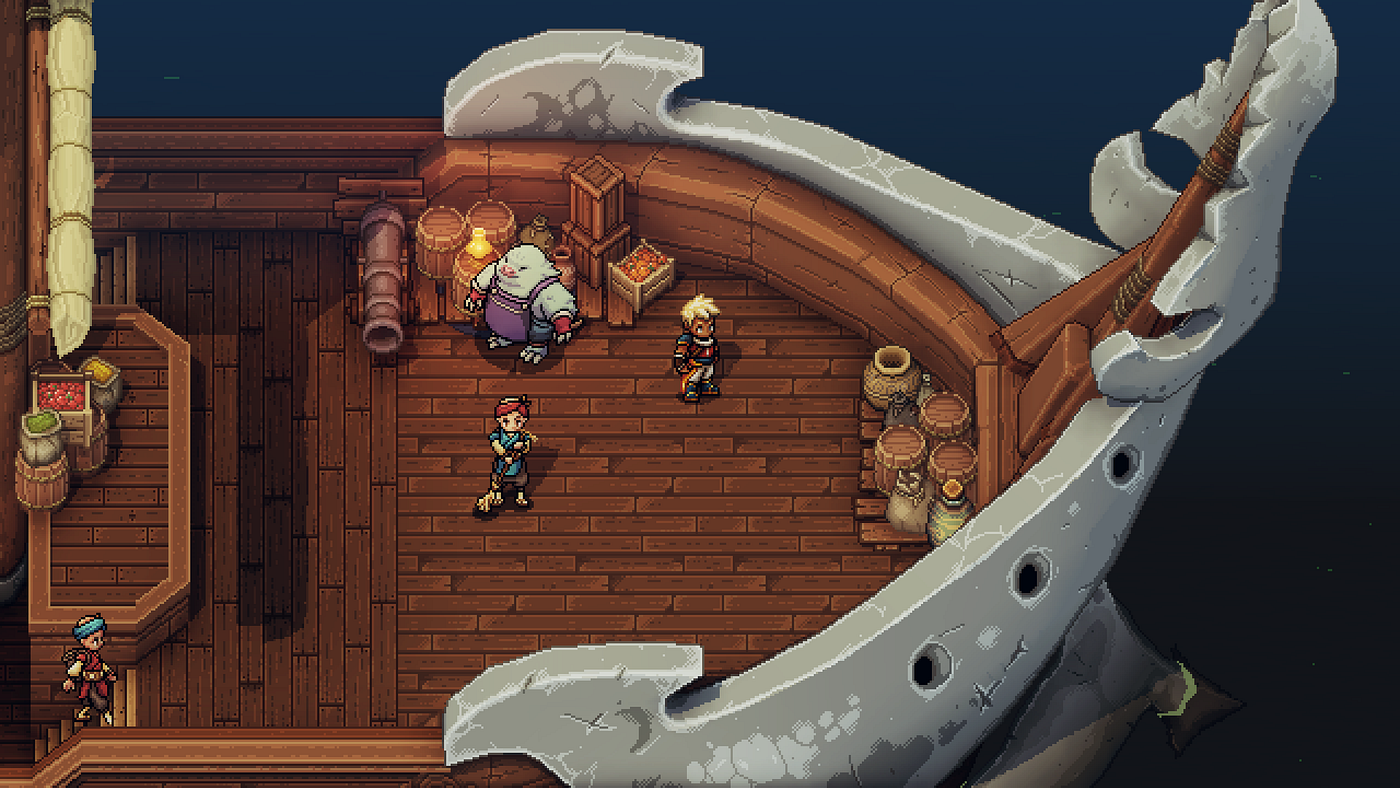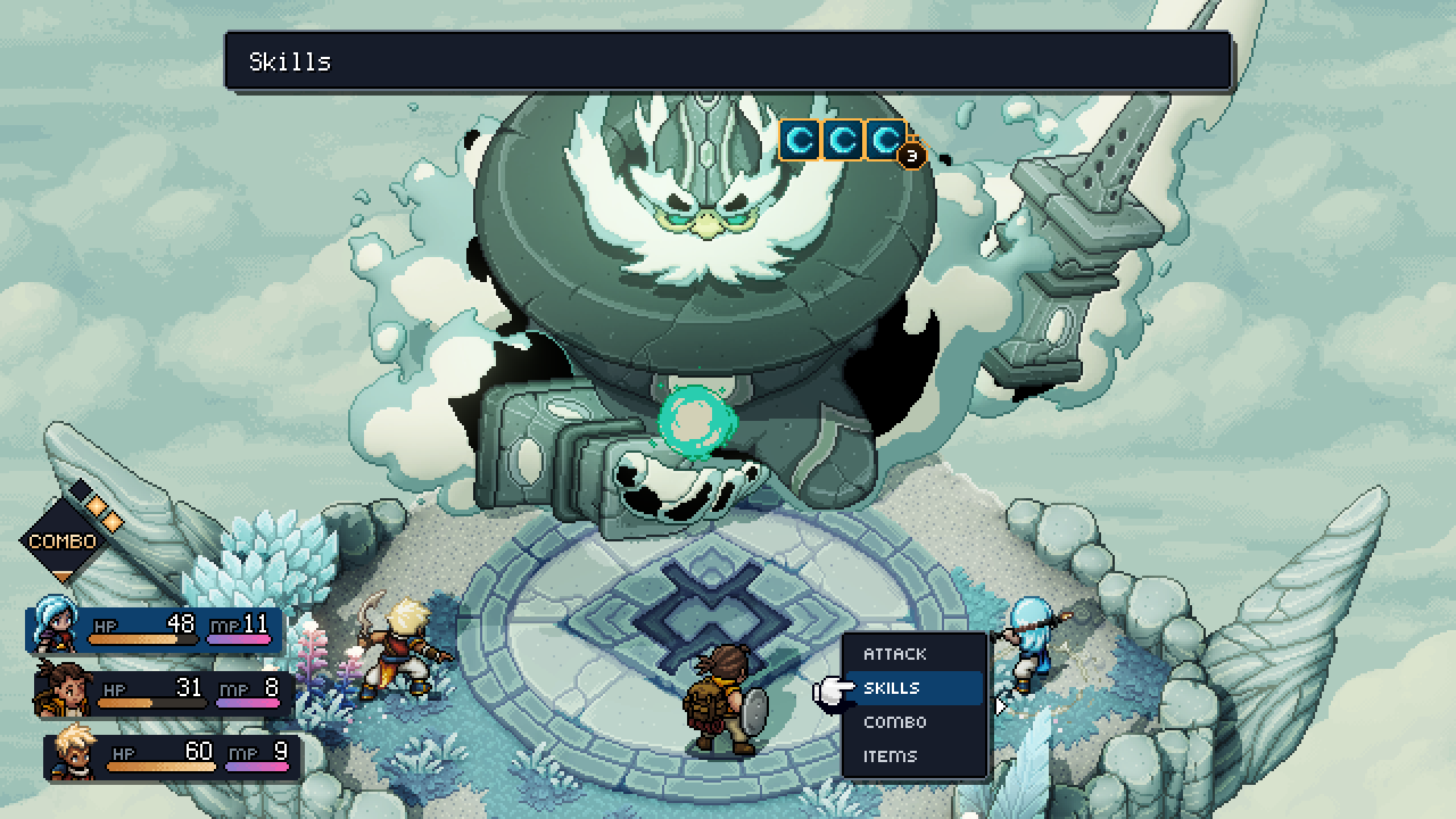Disclaimer: I contributed to the Kickstarter campaign for Sea of Stars when it was announced in 2020.
Disclaimer 2: This review is spoiler-free.
Vibe Check
About halfway through my initial playthrough of Sea of Stars, the latest indie hit from The Messenger developer Sabotage Studio, a thought occurred to me: This game is basically if Donkey Kong Country 2 were an RPG.
Obviously, I am not saying the actual content of Sea of Stars is anything like DKC2. There are no demure monkeys playing electric guitar, no smiling swordfish to ride, and no bananas to collect. But this shiny new RPG reminds me of the SNES classic in how it prioritizes vibes above all else. As a result, Sea of Stars makes me feel the same way I do when I revisit DKC2: enamored with its charm, compelled by its eeriness, and magnetized to its secrets.
Now, when I discuss a game’s vibes, I’m not referring to a specific definition or set of rules. It’s more fundamental than that—determining whether something has good or bad vibes relies on actual play experience and the various emotions going through the player’s head whilst simply existing in a particular virtual universe. To figure out if you like a title’s vibes, just ask yourself a few simple questions: Do I like being here? Do I want to see more? Does it matter if I don’t fully understand why I’m here, but wish to stay anyway?
With Sea of Stars, the answer to all three of those questions is a resounding “yes.” The game certainly has its flaws, but none of its drawbacks could overtake how much I have enjoyed just spending time in its world, surrounded by its inhabitants and surviving its trials. In short: Sea of Stars’ vibes are immaculate.

Sea of Vibes: The Story, World, and Environments of Sea of Stars
The basic plot of Sea of Stars centers on two “Solstice Warriors,” magic-wielding individuals who utilize the power of the Sun or the Moon, named Zale and Valere, who go on a quest with their childhood friend Garl (notably NOT a Solstice Warrior) to take on mystical beings who terrorize the land. Much like its RPG forefathers, Sea of Stars’ plot progresses in a fairly predictable manner until a firm act of betrayal, followed some hours later by a single unexpected twist and then a final showdown in the end.
Unfortunately, Sea of Stars’ greatest weaknesses lie in its story and the presentation thereof. Narratively, the game doesn’t offer much outside of largely understood fantasy and sci-fi tropes, and the writing doesn’t pack enough of a punch to make predictable outcomes feel all that weighty (with certain exceptions, of course).
Additionally, the actual script could have used some extra proofreading, as it contains numerous errors that seem fairly fixable (lots of comma splices, question marks in the wrong places, etc.). The story does contain some emotionally potent moments, and the general character dialogue succeeds for the most part, but don’t expect anything too out of the ordinary here.
Strangely enough, though, the somewhat lacking main story clears the path for other narrative components to really shine. Where Sea of Stars falters in plot, it excels in character interactions, worldbuilding, and its highly interactive environmental design. The game’s true narrative experience centers more on traversing through jungles and mountains, playful chats among friends, devising effective battle tactics, playing rounds of Wheels in every tavern, and building a better future for the people around you.

Strongest of Vibes: The Art
Sea of Stars’ arguably greatest strengths are immediately apparent from a single glance: its art direction, which is nothing short of gorgeous, and its world design, which delighted me at nearly every turn.
The visual style—which one could describe as a modernized take on PS1-era RPG art (think a sharper Wild Arms) —often goes back and forth between lush, brightly colored environments with a tinge of danger and dark haunts peppered with small but dazzling hues. The prettiest beaches have dangerous, craggy cliffs while the creepiest swamps contain glowing mushrooms and bright green candlelights.
Outside of the more vibrant areas, some of the most striking theaters of action in Sea of Stars are the gloomy, depressing locales livened up by the vivacity of your squad. Zale and Valere bring a faint but noticeable glow to every room they enter, making the detailed design of every haunted mansion, abandoned fortress, and celestial prison even more apparent. Bringing the light of the Sun and the Moon to the spookiest of places without drowning out the darkness creates a vibe that’s not easy to pull off, but Sea of Stars pulls it off.
The game’s aesthetics also feature some creative 2D environmental design, with secret chests and caves hidden behind M.C. Escher-lite level architecture. Sea of Stars constantly plays with perspective and challenges the player to test out alternate routes, and the pseudo-labyrinthine nature of certain environments turns seemingly basic areas into Zelda-like dungeons. Traversal in Sea of Stars involves more than staring in awe at beautiful landscapes and structures: it presents some of the most engaging gameplay components of the entire experience.
To figure out if you like a title’s vibes, just ask yourself a few simple questions: do I like being here? Do I want to see more? Does it matter if I don’t fully understand why I’m here, but wish to stay anyway?

The Moon Also Rises: The Combat of Sea of Stars
The cornerstone of any good RPG is its combat system, and Sea of Stars absolutely delivers in this department. The turn-based battle system has shades of Chrono Trigger (no random encounters, all enemies are visible ahead of combat) and the Mario & Luigi series (active combat inputs, combo abilities), but presents enough of its own twists. Most notably, enemies telegraph the number of player moves before their attacks, and the player can prevent enemy specials by deploying certain kinds of attacks within a set number of moves.
The balancing act found in combat encounters forces the player to utilize each character’s unique strengths, such as Zale’s powerful sun blast attack (which deals a lot of damage to one or two targets) and Valere’s “moonerang” ability (which can deal many low-damage attacks to multiple enemies, so long as the player consistently deflects the attack in a timely manner). Even the easiest of battles force the player to think critically about whether to use an elemental-based skill early on, or simply begin with a basic attack.
Every combat encounter exudes incredible vibes. The fast-paced battle theme builds up the hype, and each animation teems with colorful, kinetic brilliance. The brightly-hued attacks liven up the most daunting arenas of battle, and even the spookiest enemies bring a modicum of whimsy to their actions, such as ghouls doing a little dance before a vicious blow. The whole system presents the gravitas of a serious fight, but with enough charm to remind the player that this is all supposed to be fun.

Counting Stars
Of all the ways to determine a game’s quality, I ultimately lean on vibes the most. I wouldn’t necessarily argue that good vibes trump everything else, but they’re the final piece that can elevate a game from serviceable to triumphant. A bad game can have good vibes, but a great game can’t have bad vibes.
Sea of Stars brought me in with its clever gameplay, pretty worlds, and exciting battle system, but the vibes made me want to stay. The vibes compelled me to seek out secret treasures. The vibes made me seek out every possible fight with aplomb. The vibes even allowed me to overlook some of the wonkiness of the plot (and the writing). Most of all, the vibes made Sea of Stars truly stand out in an especially difficult year to do so.
Score: 9.3/10
LIGHTNING ROUND THOUGHTS:
- I know I mentioned this in passing, but I need to give Rainbowdragoneyes and the legendary Yasunori Mitsuda their flowers for Sea of Stars’ incredible soundtrack (I especially appreciate the inclusion of modified tracks from The Messenger). (If you want to hear more thoughts on gaming music, check out our Friday Fortissimo series.)
- If I had to describe how the various world traversal feels (i.e., climbing, jumping across gaps, sidling along walls), I’d say it feels like a 2D, isometric version of Uncharted.
- The side characters in this game are phenomenal, particularly Garl, who breathes life into every single moment with his immeasurable charm and earnestness.
- I had a good time with Wheels, the playable board game at certain taverns, but Sea of Stars doesn’t provide particularly great instructions on how to play (or how to strategize).
- The towns in Sea of Stars are typical RPG fare, as they all contain NPCs having one sentence of dialogue, a handful of useful treasure chests, and the occasional side quest that takes just minutes to complete. There’s nothing revolutionary about these towns, but they scratch the itch well enough.
- Every boss battle in Sea of Stars is magnificent. Each comes with unique combat mechanics and hazards to navigate, as well as vivacious animations and stunning visual design.
- The finishing minigame is decent enough (though particularly challenging in certain ponds), but I love how basic hunter-gathering plays a key role in the minute-to-minute gameplay experience, as all healing items must come in the form of cooked meals. There’s nothing quite like fighting for your life against ghoulish nightmare creatures and then munching on a mushroom scramble to give yourself some breathing room.
- Random things I liked: gorgeous backdrops, special skill animations, cooking sound effects, pirate buddies
- Random things I disliked: too many load screens, lackluster campfire dialogue
- Without spoiling anything: A late-game twist genuinely surprised me and rocked me to my core. Sure, the overall plot of Sea of Stars is fine enough without being especially interesting at all times, but this one single moment (and the immediate aftermath) really hit me in the feels. Even the simplest story can have emotionally affecting moments.
Sea of Stars released on August 29, 2023, for PC, Nintendo Switch, PlayStation 4, PlayStation 5, Xbox One, and Xbox Series X/S. It is also included on both Game Pass and PlayStation Plus Extra/Premium.
Sam has been playing video games since his earliest years and has been writing about them since 2016. He’s a big fan of Nintendo games and complaining about The Last of Us Part II. You either agree wholeheartedly with his opinions or despise them. There is no in between.
A lifelong New Yorker, Sam views gaming as far more than a silly little pastime, and hopes though critical analysis and in-depth reviews to better understand the medium's artistic merit.
Twitter: @sam_martinelli.












1 Comment
i listened to the ost while reading this review and it was indeed vibe city. love this review and just the analysis of what vibes are in games in general. “A bad game can have good vibes, but a great game can’t have bad vibes.”